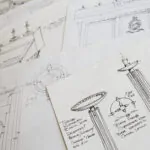The art of patent filings implies a comprehensive understanding of the entire patent application process, including the preparation of clear and informative patent drawings. Patent drawings play a crucial role in conveying the details of an invention visually and are often a requirement for all patent applications. Here, we’ll take a closer look at patent drawings and provide insights into creating effective drawings for your own patent filings.
- Understanding the Purpose of Patent Drawings:
Clarity and Precision: Patent drawings should be clear, precise, and capable of conveying the invention without obscurity.
Complementary to Description: Drawings should complement the written description and claims, providing additional clarity and detail of the invention.
- Key Elements of Patent Drawings:
Views: Including different views such as perspective, top, side, and cross-sectional views etc. as needed.
Numbering and Labels: Clearly number and label each part of the drawing to correspond with the description in the patent application.
Scale: Ensure that the scale of the drawing is appropriate and include measurements if necessary.
Shading and Hatching: Use shading and hatching to highlight different parts and distinguish between materials or elements.
- Types of Patent Drawings:
Utility Drawings: Utility Drawings are used to illustrate the structure and functionality of the invention. It contains numberings and helps to provide a clear and detailed understanding of how the invention works.
Design Drawings: Design drawings showcase the ornamental design or appearance of the invention. Unlike utility patents that protect the functional aspects of an invention, design patents protect the ornamental or aesthetic aspects of the invention. Usually, 7 standard views cover the entire invention, however inventor may add as many he believes that would suffice his design patent application.
Flowcharts and Diagrams: Flowcharts and diagrams are valuable tools in patent applications, particularly when describing processes, methods, or systems. They provide a visual representation of the steps involved, the relationships between components, and the overall structure of an invention.
- Compliance with Patent Office Guidelines:
Follow Format Guidelines: Different patent offices may have specific requirements for drawings. We need to ensure the compliance of these guidelines. It is always good to have a professional patent draftsman who ensures the drawings meet with the guidelines of PTO.
File Formats: Usually, a PDF format file is sufficient to submit drawings. The formal drawings, often in black and white, are all required by the PTO.
- Hiring Professional Draftsmen:
Consider Professionals: For complex inventions, consider hiring professional draftsmen or illustrators with experience in patent drawings.
Communication: Clearly communicate with the draftsmen to ensure accurate representation of the invention.
- Patent Drawing Checklist:
Accurate Depiction: Ensure that drawings accurately depict the invention as described in the application.
Consistency: Maintain consistency across all drawings in terms of style, scale, and labeling.
Legibility: Drawings should be legible and not cluttered.
- Iterative Process:
Review and Revise: Regularly review and revise drawings during the patent application drafting process. It is easy to revise the drawings before having any objection from the patent office examiner.
Feedback: If you have hired a patent attorney they seek feedback from patent attorneys or experts to improve the quality of the drawings. This can help reduce your costs and time.
- Technology Tools:
Use CAD Software: Nowadays patent drawings are created digitally using computer software like Computer-Aided Design (CAD) software that can enhance the precision and professionalism of patent drawings. There are other software like Visio or Coreldraw that are often used to create drawings.
Digital Rendering: In a design drawing, there are minor details that should be captured of invention to make the precise drawings. And using digital rendering for design patent drawings is the best way to get it.
- Patent Drawing Examples:
Online Resources: Explore online patent databases for examples related to your field.
Professional Examples: Analyze drawings from professionally drafted patents for guidance








